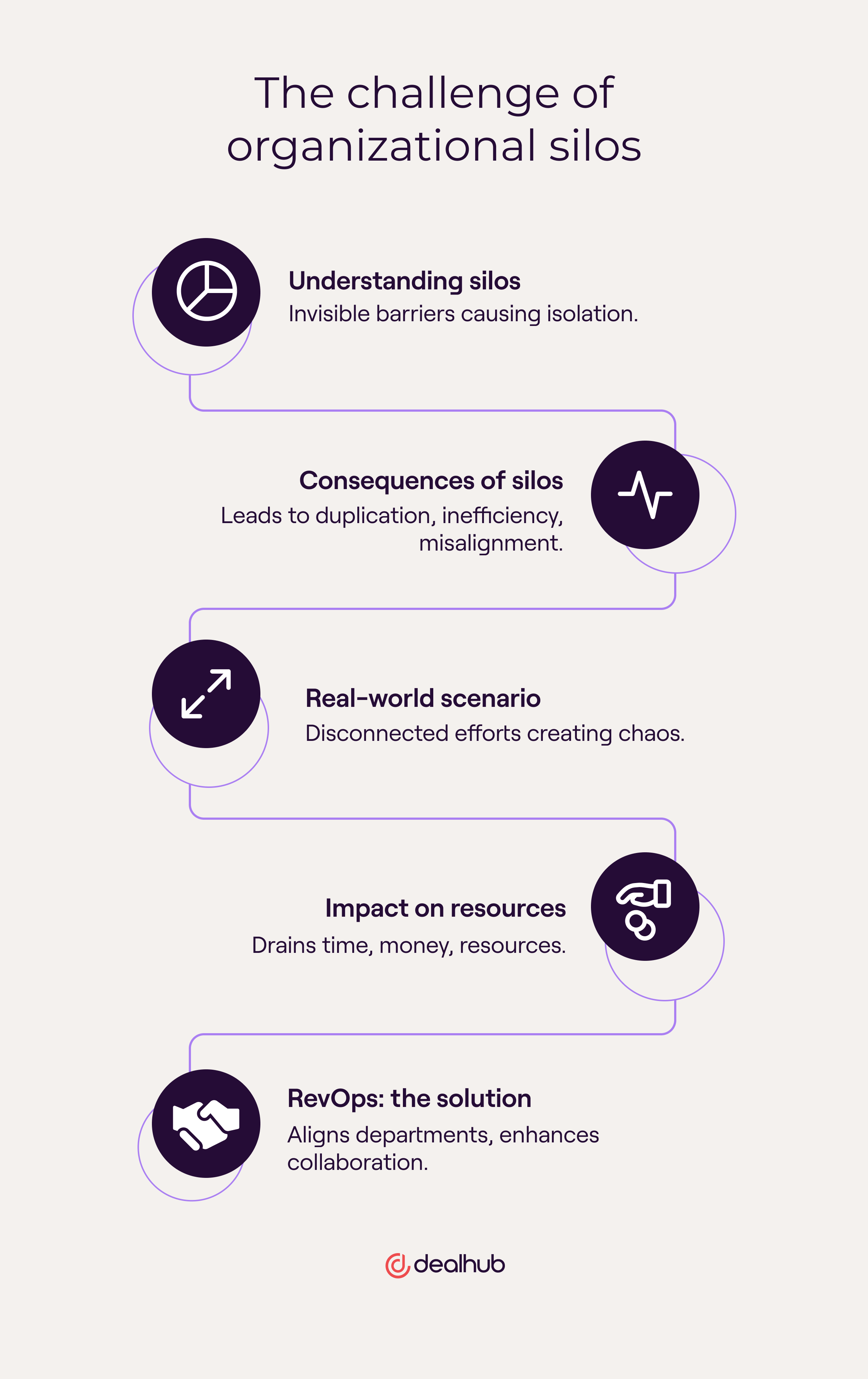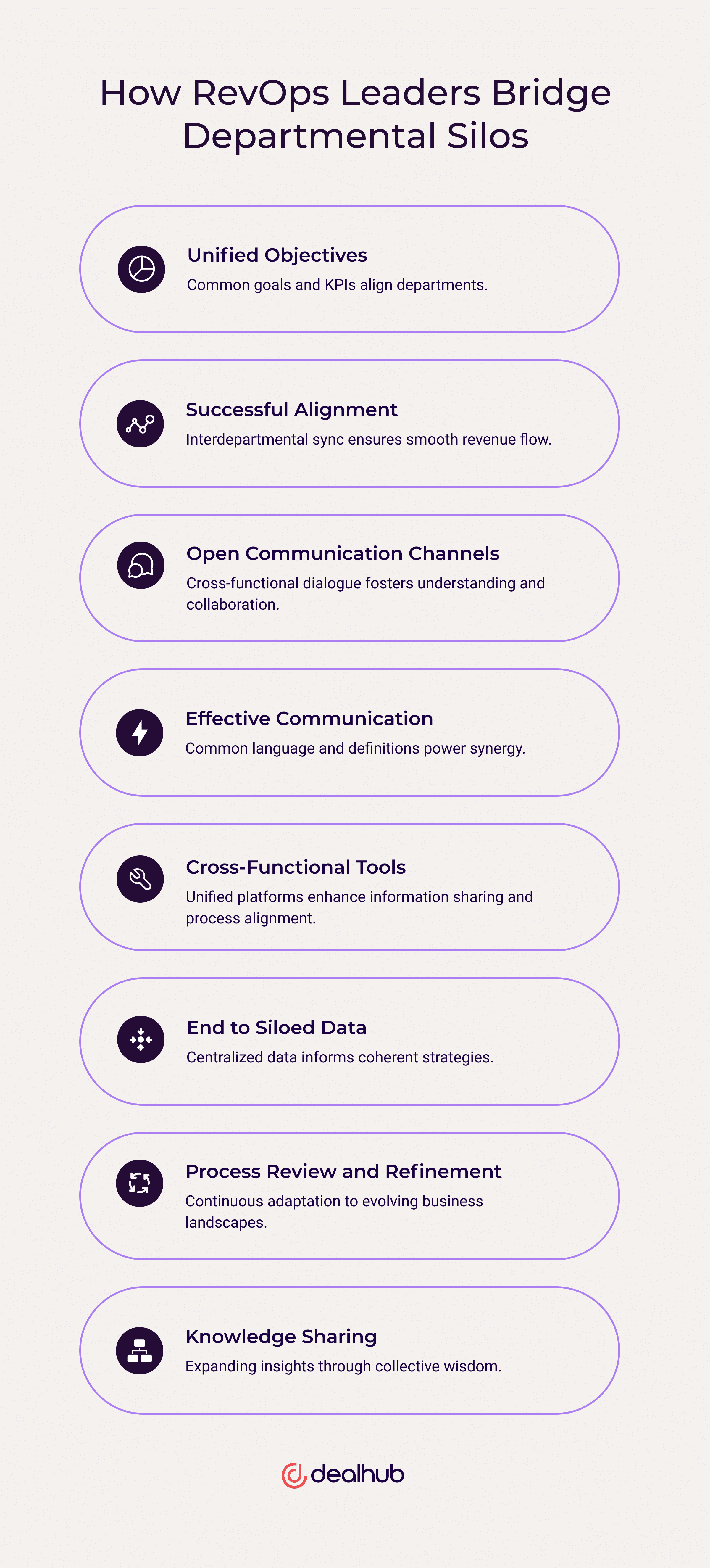At DealHub, we’ve worked with many RevOps leaders over the past few years and have witnessed firsthand how they developed their strategies and shaped their departments to bridge organizational silos and meet revenue growth goals. And we want to share what we’ve discovered!
From establishing unified objectives, fostering open communication, and leveraging technology and tools, we’ll break down how some of the most prolific RevOps teams are reshaping their departmental structure to drive revenue and nurture growth.
The challenge of organizational silos

Organizational silos are like invisible walls that keep departments isolated from one another. These barriers can harm revenue growth by fostering an environment that leads to:
- Duplicated efforts
- Inefficiencies
- Misaligned goals
Imagine running one campaign through marketing with sales pursuing a completely different audience while customer success struggles to satisfy customers who aren’t quite sure what to expect. It’s a recipe for confusion and chaos that can drain time, money, and resources. It’s also typically how siloed departments function day to day. RevOps offers a different path and has reimagined how sales, marketing, and customer success approach the client – and each other.
The promise of RevOps: unifying marketing, sales, and customer success
RevOps promises to unify departments and boost revenue, but it’s not one-size-fits-all solution. It’s a strategic approach tailored to each organization’s needs. Let’s explore the nuances in how various companies apply RevOps in their sales and marketing strategies.
How RevOps leaders are bridging departmental silos

Unified objectives
RevOps leaders are masters at defining common goals and aligning Key Performance Indicators (KPIs) across departments. The secret is to use metrics that resonate with marketing, sales, and customer support – and make sense to the overall business objectives. Imagine a workplace where everyone understands what success looks like and how they contribute to it. In such an environment, sales, marketing, and customer success teams all have the same goal and build internal strategies around how to help each other achieve the shared objective. This is the vision of a well-aligned RevOps team.
What successful alignment looks like
Olga Traskova, VP of Revenue Operations at TigerConnect (a healthcare collaboration platform), is a RevOps expert. For Olga, successful alignment is the key to an effective RevOps strategy. As marketing, sales, and customer success sync, revenue flows naturally, and customers receive a consistent experience.
According to Olga, “Marketing has a lot of data because of the tech stack. […] It’s not just implementing tools. It’s not just throwing out processes, but it’s looking at the end game. The end game is always revenue [and] looking at what’s working and why we should be doing this and working in alignment with all of the cross-functional departments.”
Open communication channels
Alignment and what to do with the data you collect starts with communication – the glue that holds cross-functional teams together. RevOps leaders like Olga understand this and work tirelessly to break down communication barriers by creating a common language. When all departments speak the same language and understands each other’s needs, collaboration thrives, revenue soars, and customers are happy. RevOps works to link departments together to ensure communication happens.
After all, “CSMs cannot work in a silo without marketing,” Olga points out. “Depending on the motion, depending on the playbook, depending on what we’re trying to solve for, RevOps is this orchestrator…We are there to make sure that everyone, everything is flawless and that everyone is aware of the major initiatives.”
Effective communication for the win
Having open communication channels is just that start. Once channels are created, communication has to run through them – and it has to be effective. For that, teams need to invest in creating a common language.
Ben Rubin, Revenue Director at Remotish (the HubSpot RevOps specialists), is a seasoned revenue leader and an expert on effective cross-functional collaboration. On the DealHub RevAmp Podcast, Ben explains how removing friction across RevOps teams can increase efficiency and alignment. To do this, developing a common terminology and workflow that all departments can easily understand is a critical step in managing an effective RevOps strategy.
For example, as Ben points out, “when does it become a sales accepted and sales qualified lead? What are those definitions? You’ve got to define that. And you need both of those department heads working together to define that.”
Implementing cross-functional tools
Effective communication is nurtured with the help of communication tools. When put into place, these tools break down operational silos and help build more effective communication between teams. RevOps leaders like Ben implement and integrate tools that cater to multiple departments. The emphasis here is on synchronized and streamlined sharing. Think about it like having all the puzzle pieces in one place to make putting them together a lot easier.
For Ben, it’s essential to have processes that transcend departments. “[Have] the simplest form of an agreement and clarify the expectations on what both parties are going to do. When you start to see people think that way, that’s when collaboration starts.”
Implementing shared tools like CRMs, playbooks, and sales enablement platforms can help teams align data and processes that will alleviate friction and smooth the path for better information sharing, ultimately leading to a smoother sales process and a seamless customer experience.
Putting an end to siloed data
If you have communication channels and a shared language in place, congratulations, you’re almost there! But there’s still more to do to bridge the gap between understanding and action. For example, different departments traditionally have access to various datasets and may have built their strategy around different KPIs. However, when data is also centralized, a clearer picture can take shape, leading to more informed decision-making.
Mollie Bodensteiner, Head of Revenue of Operations at Syncari and RevOps guru, wants companies to recognize the critical link between RevOps and Business Intelligence (BI). The first step: understanding what data you have.
“Map the flow of data between your tools,” suggests Mollie. “And it doesn’t have to be some crazy fancy diagram. But you need to understand what your tech stack is.”
By understanding your data and how it moves between tools and teams, you’ll better understand why to track it and how to use it.
Continuous process review and refinement
Adaptability is the key to keeping the alignment intact. RevOps leaders emphasize the importance of regular assessments and feedback loops. Remember that the business landscape – and your customer – is constantly evolving, so whatever processes you put in place need to be flexible enough to roll with change.
“Everyone talks about the single view of the customer,” Mollie admits. “You want to have that unified customer data set that you have to understand your business and tell that story, but you’re never done with that. It’s never finished. You’re building this foundation that you’re iterating on, and you’re going to continue to evolve on it.”
Therefore, once you have a shared dataset, be mindful that you may need to introduce new KPIs as the business landscape shifts, and your teams need to be open to receiving new information that can help them refine their internal processes as well.
Sharing knowledge across teams
Your team has the building blocks for continued success when you have the proper communication channels, a shared language and dataset, and the willingness to evolve over time. After that, it’s all a matter of sharing knowledge to optimize and adapt so that you can grow revenue over time.
Alan Hawley, Chief Revenue Officer for Tomorrow.io, is a master in building go-to-market strategies. During a recent DealHub RevAmp podcast, Alan discussed the importance of knowledge sharing across teams. In the case of Tomorrow.io, their unique challenge and opportunity was having a diverse client base that encapsulated everything from airlines to sports teams. Having a cohesive message and strategy across disparate verticals was essential.
Knowledge sharing became a critical element of effective communication with clients.
“You get more customers, you get more feedback,” says Alan. “So you start to tailor the solutions. You start to tailor your marketing messaging. [W]e build these playbooks by industry, which really [becomes the] Bible to any sales representative.”
By listening to client feedback and tying in industry-specific details under sales playbooks, Tomorrow.io could effectively share knowledge across teams and easily translate their product’s unique value proposition to different verticals – all while staying flexible enough to adjust their winning strategy over time.
RevOps: the bridge to departmental alignment
In the past, departmental silos had a knack for hindering growth. Organizations, however, are much more adept at internal communications, and with the advent of RevOps, there is light at the end of the tunnel for teams that lack cohesion. A robust RevOps strategy has the power to align marketing, sales, and customer success. Under its guidance, each department begins pushing towards the same goal. By working as a single, well-oiled machine, internal teams can propel revenue to new heights.
RevOps leaders set the stage for alignment by establishing unified objectives, promoting open communication channels, implementing cross-functional tools, and embracing continuous process review and refinement. Think of them as coaches or team captains who ensure each unit uses its internal capacity to move the ball forward.
The benefits are clear: increased revenue, more satisfied customers, and a harmonious, efficient organization. Unity is strength, and RevOps is the internal mechanism that can bridge gaps, remove sales operations silos, and pave the way for continued growth.
To hear more thought leaders in the RevOps space, listen to The Revenue Amplification Podcast Series by DealHub. New episodes drop every Thursday, and you can sign up to be the first to hear the latest RevOps insights from those on the front lines of this exciting new business trend.





